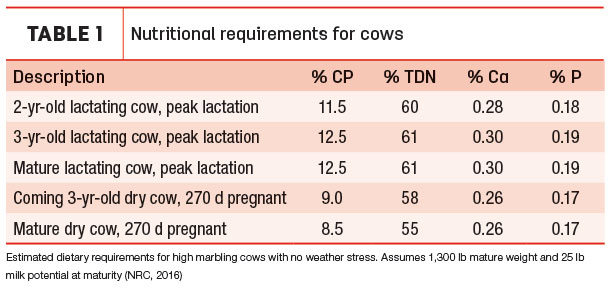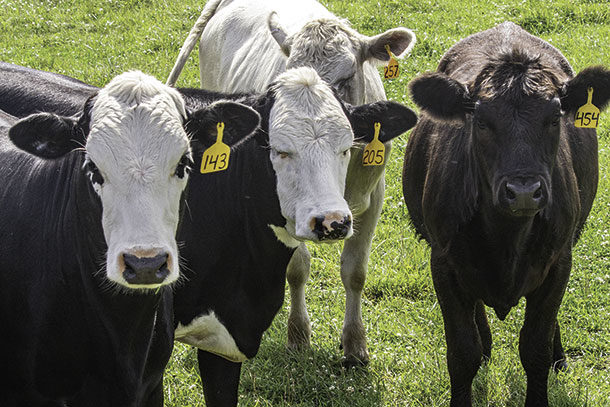The maintenance factor for steers and replacement females is a constant mathematical formula with several variables. The biggest final question: When am I going to supplement and what will I use?
Those factors were spelled out at the Texas A&M Beef Cattle Short Course, held online in early August, in a presentation by Dr. Jason Banta on cow and stocker nutrition. Banta, an associate professor and Texas AgriLife Extension beef specialist, used several questions sent in by participants before and during the online presentation.
Nutrition factors for stocker cows are heavily determined by body condition score, Banta explained, because of the impact it has with conception rates. Mature cows need to be at a body conditipn score (BCS) of 4 or higher, but a starting range of 5 is preferable.
“We like them greater than 5 if we do that as best we can without additional supplementation, and then at calving. BCS at calving is going to be the most important as far as impacting pregnancy rate for breed-up.”
Steady feed patterns
To balance the needs for crude protein and total digestible nutrients (TDN), Banta showed varying requirements for females based on age (see Table 1). The key goal is to make sure cows are not gaining or losing weight. “The lowest we’re going to see on [a] mature cow four weeks before calving is 55 TDN and 8.5 protein. If they’re above 61, they won’t need any energy supplement,” Banta said.”

For example, a BCS 3 cow needs more crude protein to add tissue and muscle to hit targets. A BCS 7 cow, on the other hand, can see reduced TDN to lose extra condition “because we have room to lose weight and use that extra condition.”
Forage quality and minerals
Banta explained the equal balance between good forage and good intake for stockers. As forage quality declines, cattle are not going to increase intake, and it will affect them later on with mineral supplementation needs.
“People have the misconception, ‘My hay isn’t that good, so she’ll just eat more of it, and it will be OK.’ Actually, with that low-quality hay, she eats less of it and makes that deficit much greater. Whereas, with higher-quality forages, animals are able to eat more of it, and so we see some better performance.”
Common factors that affect forage and hay quality include species and cultivar, maturity, temperature, nitrogen fertilizer, rained-on hay and when the hay was baled. Other key rules of thumb:
- Cool-season forages will be higher quality than warm season.
- Forages from new seed are greater in quality than perennials.
- Forages grown in arid environments are greater in quality than those in humid environments.
Combinations in forage
Banta said that depending on the quality of certain forages for stockers, you may need a combination to help sustain growth. For the stocker calf and replacement female, quality forage determines consumption and meeting target goals. A few examples of ranging quality with forage combinations include:
- Tifton 85, old world bluestem – average daily gain (ADG) of 1.0 to 1.6
- Hybrid bermudagrass, bahiagrass – ADG- 0.75 to 1.25
- Sorghum-sudangrass, or just sudangrass – ADG of 2.0 to 2.75
- Crabgrass and pearl millet – ADG of 1.25 – 2.0
- Ryegrass, small grains (rye, wheat, oats, barley, triticale) – ADG of 1.5 to 2.85
Choosing supplements
Banta laid down a hard rule that stockers must understand when choosing additional nutritional supplements: Cheap and easy doesn’t exist.
On the positive side, if your hay is in solid shape, you won’t need much supplementation, if at all.
Typically, late summer is the usual period for supplement options when forage quality begins to decline. Other times exist during winter in rougher rangeland environments.
Some producers ask whether to choose a protein or energy supplement, or a combination. Banta says use your pocketbook to help make the decision. From a cost-per-unit or concentration standpoint, both energy and protein do find their way into the mix.
- Energy sources – Whole corn, 11%-14% cubes, soybean hulls, wheat midds, rice bran
- Energy plus protein sources – 20% cubes, corn gluten feed, distillers grains, winter pasture, whole cottonseed (maximum 25% diet)
- Protein sources – cottonseed meal, 38% or 40% cubes, soybean meal, sunflower meal, alfalfa hay, winter pasture, urea (a limited amount in the right situation)
Hand-feed supplements
Banta also gave considerations for handfed supplements delivered in cube piles or from a sack. First, it’s easy to increase or decrease the amount in the diet, based on feed and conditions.
Producers have several options to choose from, and it can be cheaper per unit of nutrient, especially TDN. Labor associated with delivering the feed is also factor.
Cottonseed meal is often a go-to resource with its 41% protein, and it works well as a protein supplement with low-quality hay. Whole-shell corn is an affordable energy supplement, and it is often undervalued in its utility. Some will worry if it is a waste, as it passes through the cow, but its TDN value remains high compared to the higher cost of steam-flaked or ground corn.
Mixing the two items, one-third cottonseed meal with two-thirds whole corn, is a useful tool with high values of both corn and protein.







